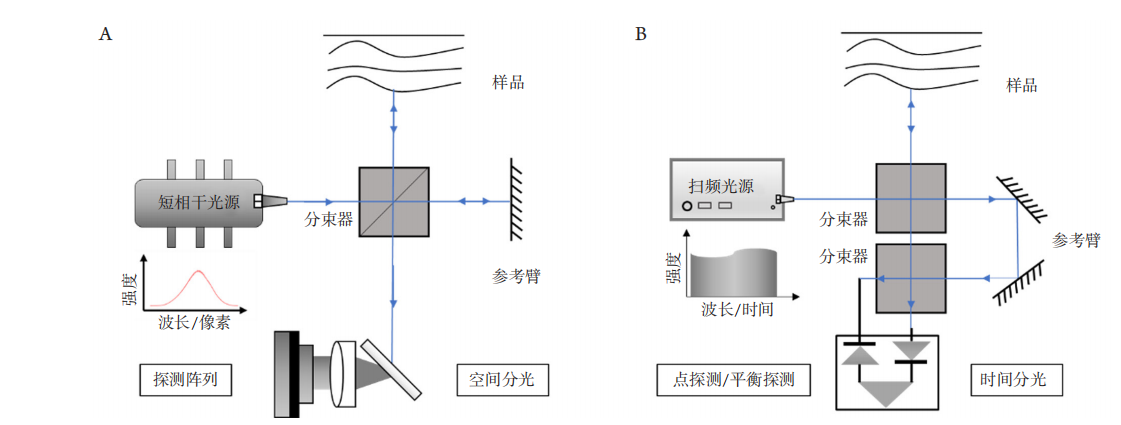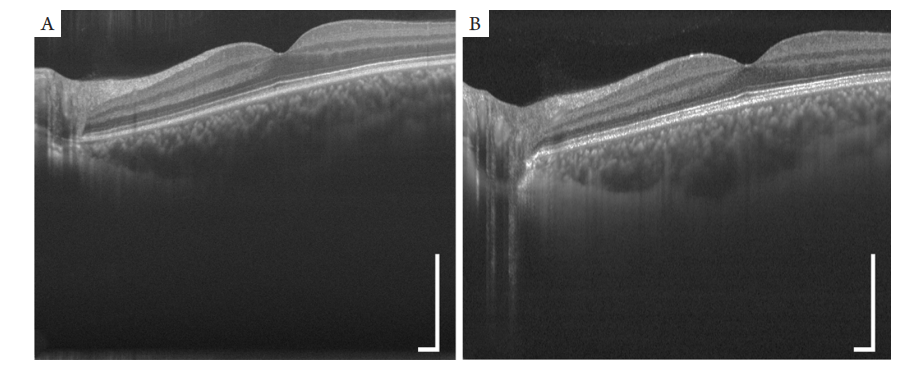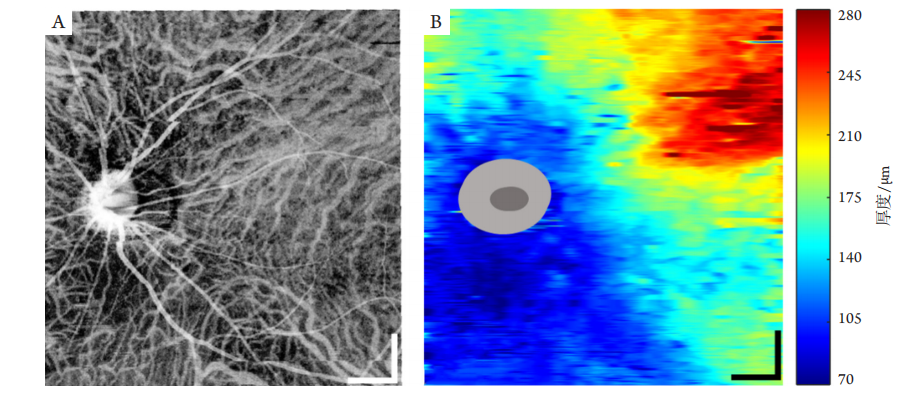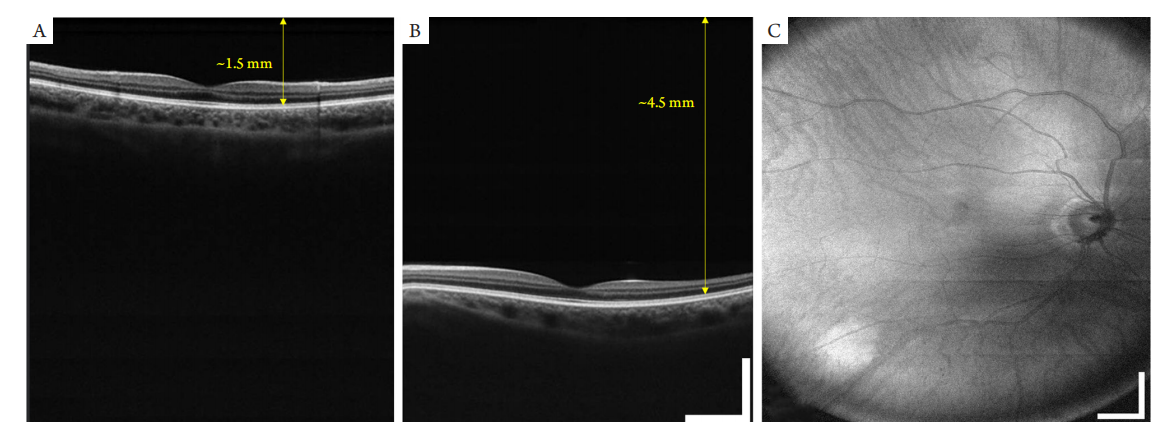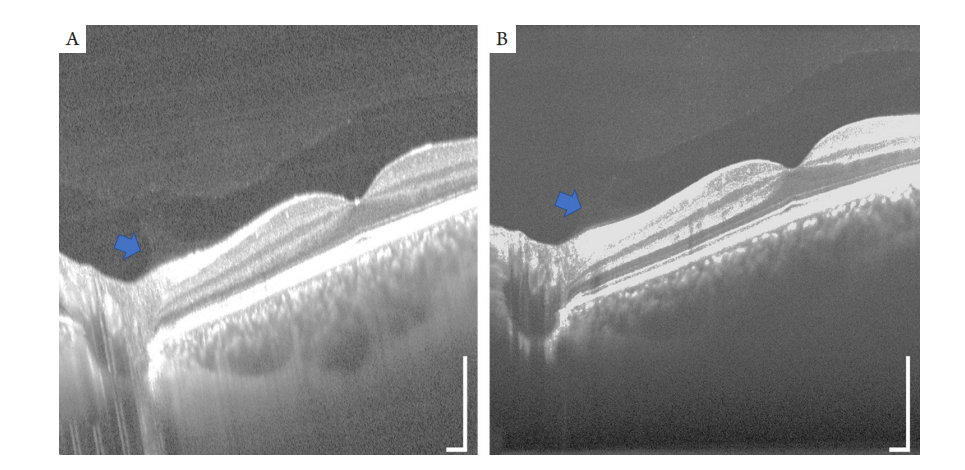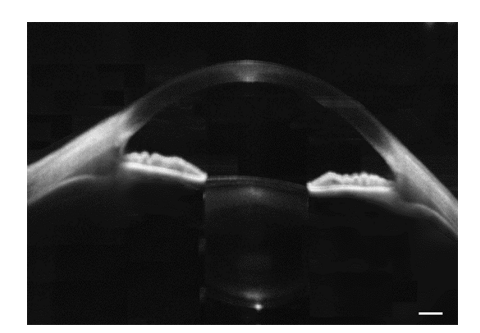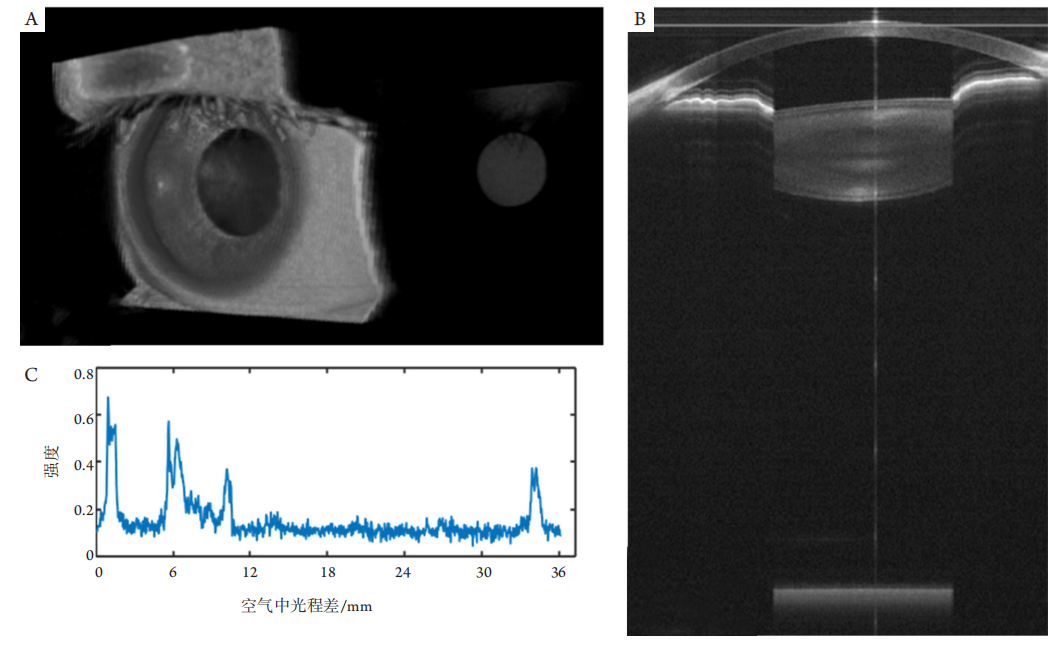1、Choma MA, Sarunic MV, Yang CH, et al. Sensitivity advantage of swept
source and Fourier domain optical coherence tomography[ J]. Opt
Express, 2003, 11(18): 2183-2189.Choma MA, Sarunic MV, Yang CH, et al. Sensitivity advantage of swept
source and Fourier domain optical coherence tomography[ J]. Opt
Express, 2003, 11(18): 2183-2189.
2、de Boer JF, Cense B, Park BH, et al. Improved signal-to-noise ratio
in spectral-domain compared with time-domain optical coherence
tomography[ J]. Opt Lett, 2003, 28: 2067-2069.de Boer JF, Cense B, Park BH, et al. Improved signal-to-noise ratio
in spectral-domain compared with time-domain optical coherence
tomography[ J]. Opt Lett, 2003, 28: 2067-2069.
3、Leitgeb R, Hitzenberger CK, Fercher AF, et al. Performance of fourier
domain vs. time domain optical coherence tomography[ J]. Opt
Express, 2003, 11: 889-894.Leitgeb R, Hitzenberger CK, Fercher AF, et al. Performance of fourier
domain vs. time domain optical coherence tomography[ J]. Opt
Express, 2003, 11: 889-894.
4、Wojtkowski M, Leitgeb R, Kowalczyk A, et al. In vivo human retinal
imaging by Fourier domain optical coherence tomography[ J]. J
Biomed Opt, 2002, 7(3): 457-463.Wojtkowski M, Leitgeb R, Kowalczyk A, et al. In vivo human retinal
imaging by Fourier domain optical coherence tomography[ J]. J
Biomed Opt, 2002, 7(3): 457-463.
5、Alibhai AY, Or C, Witkin AJ. Swept source optical coherence
tomography: a review[ J]. Curr Ophthalmol Rep, 2018, 6(1): 7-16.Alibhai AY, Or C, Witkin AJ. Swept source optical coherence
tomography: a review[ J]. Curr Ophthalmol Rep, 2018, 6(1): 7-16.
6、Potsaid B, Jayaraman V, Fujimoto JG, et al. MEMS tunable VCSEL light
source for ultrahigh speed 60kHz-1MHz axial scan rate and long range
centimeter class OCT imaging[M]//Izatt JA, Fujimoto JG, Tuchin VV,
ed al. Optical coherence tomography and coherence domain optical
methods in biomedicine Xvi. Vol 8213. Bellingham: Spie-Int Soc
Optical Engineering, 2012.Potsaid B, Jayaraman V, Fujimoto JG, et al. MEMS tunable VCSEL light
source for ultrahigh speed 60kHz-1MHz axial scan rate and long range
centimeter class OCT imaging[M]//Izatt JA, Fujimoto JG, Tuchin VV,
ed al. Optical coherence tomography and coherence domain optical
methods in biomedicine Xvi. Vol 8213. Bellingham: Spie-Int Soc
Optical Engineering, 2012.
7、Drexler W, Fujimoto JG. Optical coherence tomography[C].
Nondestructive Material Testing Using OCT, 2015.Drexler W, Fujimoto JG. Optical coherence tomography[C].
Nondestructive Material Testing Using OCT, 2015.
8、Jirauschek C, Huber R. Wavelength shifting of intra-cavity photons:
adiabatic wavelength tuning in rapidly wavelength-swept lasers[ J].
Biomed Opt Express, 2015, 6(7): 2448-2465.Jirauschek C, Huber R. Wavelength shifting of intra-cavity photons:
adiabatic wavelength tuning in rapidly wavelength-swept lasers[ J].
Biomed Opt Express, 2015, 6(7): 2448-2465.
9、Pfeiffer T, Draxinger W, Grill C, et al. Long-range live 3D-OCT at
different spectral zoom levels[C]. SPIE Proceedings (Optical Society
of America, 2017), paper 104160L.Pfeiffer T, Draxinger W, Grill C, et al. Long-range live 3D-OCT at
different spectral zoom levels[C]. SPIE Proceedings (Optical Society
of America, 2017), paper 104160L.
10、Choma MA, Hsu K , Izatt JA. Swept source optical coherence
tomography using an all-fiber 1300-nm ring laser source[ J]. J Biomed
Opt, 2005, 10(4): 6.Choma MA, Hsu K , Izatt JA. Swept source optical coherence
tomography using an all-fiber 1300-nm ring laser source[ J]. J Biomed
Opt, 2005, 10(4): 6.
11、Jacques SL. Optical properties of biological tissues: a review[ J]. Phys
Med Biol, 2013, 58(11): R37.Jacques SL. Optical properties of biological tissues: a review[ J]. Phys
Med Biol, 2013, 58(11): R37.
12、Marschall S, Klein T, Wieser W, et al. FDML swept source at 1060 nm
using a tapered amplifier[M]//Izatt JA, Fujimoto JG, Tuchin VV, ed al.
Optical coherence tomography and coherence domain optical methods
in biomedicine Xiv. Vol 7554. Bellingham: Spie-Int Soc Optical
Engineering, 2010.Marschall S, Klein T, Wieser W, et al. FDML swept source at 1060 nm
using a tapered amplifier[M]//Izatt JA, Fujimoto JG, Tuchin VV, ed al.
Optical coherence tomography and coherence domain optical methods
in biomedicine Xiv. Vol 7554. Bellingham: Spie-Int Soc Optical
Engineering, 2010.
13、Pavlin C, Christopehr D, Burns P. High frequency doppler ultrasound
examination of blood flow in the anterior segment of the eye[ J]. Am J
Ophthalmol, 1998, 126: 597-600.Pavlin C, Christopehr D, Burns P. High frequency doppler ultrasound
examination of blood flow in the anterior segment of the eye[ J]. Am J
Ophthalmol, 1998, 126: 597-600.
14、Klein T, Wieser W, Reznicek L, et al. Multi-MHz retinal OCT[ J].
Biomed Opt Express, 2013, 4(10): 1890-1908.Klein T, Wieser W, Reznicek L, et al. Multi-MHz retinal OCT[ J].
Biomed Opt Express, 2013, 4(10): 1890-1908.
15、Dastiridou A, Bousquet E, Kuehlewein L, et al. Choroidal imaging
with swept-source optical coherence tomography in patients with
birdshot chorioretinopathy: choroidal reflectivity and thickness[ J].
Ophthalmology, 2017, 124(8): 1186-1195.Dastiridou A, Bousquet E, Kuehlewein L, et al. Choroidal imaging
with swept-source optical coherence tomography in patients with
birdshot chorioretinopathy: choroidal reflectivity and thickness[ J].
Ophthalmology, 2017, 124(8): 1186-1195.
16、Migacz JV, Gorczynska I, Azimipour M, et al. Megahertz-rate optical
coherence tomography angiography improves the contrast of the
choriocapillaris and choroid in human retinal imaging[ J]. Biomed Opt
Express, 2019, 10(1): 50-65.Migacz JV, Gorczynska I, Azimipour M, et al. Megahertz-rate optical
coherence tomography angiography improves the contrast of the
choriocapillaris and choroid in human retinal imaging[ J]. Biomed Opt
Express, 2019, 10(1): 50-65.
17、Farazdaghi MK, Ebrahimi KB. Role of the choroid in age-related
macular degeneration: a current review[ J]. J Ophthalmic Vis Res, 2019,
14(1): 78.Farazdaghi MK, Ebrahimi KB. Role of the choroid in age-related
macular degeneration: a current review[ J]. J Ophthalmic Vis Res, 2019,
14(1): 78.
18、Keenan TD, Klein B, Agrón E, et al. Choroidal thickness and vascularity
vary with disease severity and subretinal drusenoid deposit presence
in nonadvanced age-related macular degeneration[ J]. Retina, 2020,
40(4): 632-642.Keenan TD, Klein B, Agrón E, et al. Choroidal thickness and vascularity
vary with disease severity and subretinal drusenoid deposit presence
in nonadvanced age-related macular degeneration[ J]. Retina, 2020,
40(4): 632-642.
19、Michalewska Z, Swept-source O. Taking imaging deeper and wider[ J].
Retina Today, 2014, 11: 12.Michalewska Z, Swept-source O. Taking imaging deeper and wider[ J].
Retina Today, 2014, 11: 12.
20、Kumar P, Chawla R , Balakrishnan J, et al. ‘Solitary Idiopathic
Choroiditis’ or a tumour of scleral origin: a case report based
hypothesis[ J]. Med Hypotheses, 2020, 139: 109695.Kumar P, Chawla R , Balakrishnan J, et al. ‘Solitary Idiopathic
Choroiditis’ or a tumour of scleral origin: a case report based
hypothesis[ J]. Med Hypotheses, 2020, 139: 109695.
21、Shinohara K, Moriyama M, Shimada N, et al. Characteristics of
peripapillary staphylomas associated with high myopia determined by
swept-source optical coherence tomography[ J]. Am J Ophthalmol,
2016, 169: 138-144.Shinohara K, Moriyama M, Shimada N, et al. Characteristics of
peripapillary staphylomas associated with high myopia determined by
swept-source optical coherence tomography[ J]. Am J Ophthalmol,
2016, 169: 138-144.
22、Kim YC, Koo YH, Jung KI, et al. Impact of posterior sclera on
glaucoma progression in treated myopic normal-tension glaucoma
using reconstructed optical coherence tomographic images[ J]. Invest
Ophthalmol Vis Sci, 2019, 60(6): 2198-2207.Kim YC, Koo YH, Jung KI, et al. Impact of posterior sclera on
glaucoma progression in treated myopic normal-tension glaucoma
using reconstructed optical coherence tomographic images[ J]. Invest
Ophthalmol Vis Sci, 2019, 60(6): 2198-2207.
23、Wu J, Gerendas BS, Waldstein SM, et al. Stable registration of
pathological 3D-OCT scans using retinal vessels[C]. In Proceedings of
the Ophthalmic Medical Image Analysis First International Workshop,
Boston, MA, USA, 14 September 2014:1-8.Wu J, Gerendas BS, Waldstein SM, et al. Stable registration of
pathological 3D-OCT scans using retinal vessels[C]. In Proceedings of
the Ophthalmic Medical Image Analysis First International Workshop,
Boston, MA, USA, 14 September 2014:1-8.
24、Liu G, Yang J, Wang J, et al. Extended axial imaging range, widefield
swept source optical coherence tomography angiography[ J]. Journal of Biophotonics, 2017, 10(11SI): 1464-1472.Liu G, Yang J, Wang J, et al. Extended axial imaging range, widefield
swept source optical coherence tomography angiography[ J]. Journal of Biophotonics, 2017, 10(11SI): 1464-1472.
25、Campbell JP, Nudleman E, Yang J, et al. Handheld optical coherence
tomography angiography and ultra-wide-field optical coherence
tomography in retinopathy of prematurity[ J]. JAMA Ophthalmol,
2017, 135(9): 977-981.Campbell JP, Nudleman E, Yang J, et al. Handheld optical coherence
tomography angiography and ultra-wide-field optical coherence
tomography in retinopathy of prematurity[ J]. JAMA Ophthalmol,
2017, 135(9): 977-981.
26、The International Committee for the Classification of the Late
Stages of Retinopathy of Prematurity. An international classification
of retinopathy of prematurity. II. The classification of retinal
detachment[ J]. Arch Ophthalmol, 1987, 105(7): 906-912.The International Committee for the Classification of the Late
Stages of Retinopathy of Prematurity. An international classification
of retinopathy of prematurity. II. The classification of retinal
detachment[ J]. Arch Ophthalmol, 1987, 105(7): 906-912.
27、Russell JF, Flynn HW Jr, Sridhar J, et al. Distribution of diabetic
neovascularization on ultra-widefield fluorescein angiography and on
simulated widefield OCT angiography[ J]. Am J Ophthalmol, 2019,
207: 110-120.Russell JF, Flynn HW Jr, Sridhar J, et al. Distribution of diabetic
neovascularization on ultra-widefield fluorescein angiography and on
simulated widefield OCT angiography[ J]. Am J Ophthalmol, 2019,
207: 110-120.
28、Schaal KB, Munk MR, Wyssmueller I, et al. Vascular abnormalities
in diabetic retinopathy assessed with swept-source optical coherence
tomography angiography widefield imaging[ J]. Retina, 2019, 39(1):
79-87.Schaal KB, Munk MR, Wyssmueller I, et al. Vascular abnormalities
in diabetic retinopathy assessed with swept-source optical coherence
tomography angiography widefield imaging[ J]. Retina, 2019, 39(1):
79-87.
29、Wolff B, Matet A, Vasseur V, et al. En face OCT imaging for the
diagnosis of outer retinal tubulations in age-related macular
degeneration[ J]. J Ophthalmol, 2012, 2012: 542417.Wolff B, Matet A, Vasseur V, et al. En face OCT imaging for the
diagnosis of outer retinal tubulations in age-related macular
degeneration[ J]. J Ophthalmol, 2012, 2012: 542417.
30、Zhang Q, Lee CS, Chao J, et al. Wide-field optical coherence
tomography based microangiography for retinal imaging[ J]. Sci Rep,
2016, 6(1): 1-10.Zhang Q, Lee CS, Chao J, et al. Wide-field optical coherence
tomography based microangiography for retinal imaging[ J]. Sci Rep,
2016, 6(1): 1-10.
31、Mwanza JC, Budenz DL. New developments in optical coherence
tomography imaging for glaucoma[ J]. Curr Opin Ophthalmol, 2018,
29(2): 121-129.Mwanza JC, Budenz DL. New developments in optical coherence
tomography imaging for glaucoma[ J]. Curr Opin Ophthalmol, 2018,
29(2): 121-129.
32、Bekkers A, Borren N, Ederveen V, et al. Microvascular damage assessed
by optical coherence tomography angiography for glaucoma diagnosis:
a systematic review of the most discriminative regions[ J]. Acta
Ophthalmologica, 2020, 98(6): 537-558.Bekkers A, Borren N, Ederveen V, et al. Microvascular damage assessed
by optical coherence tomography angiography for glaucoma diagnosis:
a systematic review of the most discriminative regions[ J]. Acta
Ophthalmologica, 2020, 98(6): 537-558.
33、Liu JJ, Witkin AJ, Adhi M, et al. Enhanced vitreous imaging in healthy
eyes using swept source optical coherence tomography[ J]. PLoS One,
2014, 9(7): e102950.Liu JJ, Witkin AJ, Adhi M, et al. Enhanced vitreous imaging in healthy
eyes using swept source optical coherence tomography[ J]. PLoS One,
2014, 9(7): e102950.
34、Spaide RF. Visualization of the posterior vitreous with dynamic
focusing and windowed averaging swept source optical coherence
tomography[ J]. Am J Ophthalmol, 2014, 158(6): 1267-1274.Spaide RF. Visualization of the posterior vitreous with dynamic
focusing and windowed averaging swept source optical coherence
tomography[ J]. Am J Ophthalmol, 2014, 158(6): 1267-1274.
35、Itakura H, Kishi S, Li D, et al. Observation of posterior precortical
vitreous pocket using swept-source optical coherence tomography[ J].
Invest Ophthalmol Vis Sci, 2013, 54(5): 3102-3107.Itakura H, Kishi S, Li D, et al. Observation of posterior precortical
vitreous pocket using swept-source optical coherence tomography[ J].
Invest Ophthalmol Vis Sci, 2013, 54(5): 3102-3107.
36、Hua R, Ning H. Modified enhanced vitreous imaging modality of
spectral domain optic coherence tomography[ J]. Eye (Lond), 2021,
35(1): 351-352.Hua R, Ning H. Modified enhanced vitreous imaging modality of
spectral domain optic coherence tomography[ J]. Eye (Lond), 2021,
35(1): 351-352.
37、Liu G, Tan O, Gao SS, et al. Postprocessing algorithms to minimize
fixed-pattern artifact and reduce trigger jitter in swept source optical
coherence tomography[ J]. Optics Express, 2015, 23(8): 9824-9834.Liu G, Tan O, Gao SS, et al. Postprocessing algorithms to minimize
fixed-pattern artifact and reduce trigger jitter in swept source optical
coherence tomography[ J]. Optics Express, 2015, 23(8): 9824-9834.
38、Choi W, Mohler KJ, Potsaid B, et al. Choriocapillaris and choroidal
microvasculature imaging with ultrahigh speed OCT angiography[ J].
PLoS One, 2013, 8(12): e81499.Choi W, Mohler KJ, Potsaid B, et al. Choriocapillaris and choroidal
microvasculature imaging with ultrahigh speed OCT angiography[ J].
PLoS One, 2013, 8(12): e81499.
39、Choi W, Moult EM, Waheed NK, et al. Ultrahigh-speed, swept-source
optical coherence tomography angiography in nonexudative age-related
macular degeneration with geographic atrophy[ J]. Ophthalmology,
2015, 122(12): 2532-2544.Choi W, Moult EM, Waheed NK, et al. Ultrahigh-speed, swept-source
optical coherence tomography angiography in nonexudative age-related
macular degeneration with geographic atrophy[ J]. Ophthalmology,
2015, 122(12): 2532-2544.
40、Miller AR, Roisman L, Zhang Q, et al. Comparison between spectral-
domain and swept-source optical coherence tomography angiographic
imaging of choroidal neovascularization[ J]. Invest Ophthalmol Vis Sci,
2017, 58(3): 1499-1505.Miller AR, Roisman L, Zhang Q, et al. Comparison between spectral-
domain and swept-source optical coherence tomography angiographic
imaging of choroidal neovascularization[ J]. Invest Ophthalmol Vis Sci,
2017, 58(3): 1499-1505.
41、Zang P, Liu G, Zhang M, et al. Automated motion correction using
parallel-strip registration for wide-field en face OCT angiogram[ J].
Biomed Opt Express, 2016, 7(7): 2823-2836.Zang P, Liu G, Zhang M, et al. Automated motion correction using
parallel-strip registration for wide-field en face OCT angiogram[ J].
Biomed Opt Express, 2016, 7(7): 2823-2836.
42、Naseripour M, Falavarjani KG, Mirshahi R, et al. Optical coherence
tomography angiography (OCTA) applications in ocular oncology[ J].
Eye (Lond), 2020, 34(9): 1535-1545.Naseripour M, Falavarjani KG, Mirshahi R, et al. Optical coherence
tomography angiography (OCTA) applications in ocular oncology[ J].
Eye (Lond), 2020, 34(9): 1535-1545.
43、Venkateswaran N, Galor A , Wang J, et al. Optical coherence
tomography for ocular surface and corneal diseases: a review[ J]. Eye
Vis (Lond), 2018, 5:13.Venkateswaran N, Galor A , Wang J, et al. Optical coherence
tomography for ocular surface and corneal diseases: a review[ J]. Eye
Vis (Lond), 2018, 5:13.
44、Maslin JS, Barkana Y, Dorairaj S. Anterior segment imaging in
glaucoma: an updated review[ J]. Indian J Ophthalmol, 2015, 63(8):
630-640.Maslin JS, Barkana Y, Dorairaj S. Anterior segment imaging in
glaucoma: an updated review[ J]. Indian J Ophthalmol, 2015, 63(8):
630-640.
45、Ang M, Baskaran M, Werkmeister RM, et al. Anterior segment optical
coherence tomography[ J]. Prog Retin Eye Res, 2018, 66: 132-156.Ang M, Baskaran M, Werkmeister RM, et al. Anterior segment optical
coherence tomography[ J]. Prog Retin Eye Res, 2018, 66: 132-156.
46、McNabb RP, Polans J, Keller B, et al. Wide-field whole eye OCT system
with demonstration of quantitative retinal curvature estimation[ J].
Biomed Opt Express, 2019, 10(1): 338-355.McNabb RP, Polans J, Keller B, et al. Wide-field whole eye OCT system
with demonstration of quantitative retinal curvature estimation[ J].
Biomed Opt Express, 2019, 10(1): 338-355.
47、Mak H, Xu G, Leung CKS. Imaging the iris with swept-source optical
coherence tomography: relationship between iris volume and primary
angle closure[ J]. Ophthalmology, 2013, 120(12): 2517-2524.Mak H, Xu G, Leung CKS. Imaging the iris with swept-source optical
coherence tomography: relationship between iris volume and primary
angle closure[ J]. Ophthalmology, 2013, 120(12): 2517-2524.
48、Karnowski K, Kaluzny BJ, Szkulmowski M, et al. Corneal topography
with high-speed swept source OCT in clinical examination[ J]. Biomed
Opt Express, 2011, 2(9): 2709-2720.Karnowski K, Kaluzny BJ, Szkulmowski M, et al. Corneal topography
with high-speed swept source OCT in clinical examination[ J]. Biomed
Opt Express, 2011, 2(9): 2709-2720.
49、Mazlin V. Full-field optical coherence tomography for non-contact
cellular-level resolution in vivo human cornea imaging[D]. PSL
Research University, 2019.Mazlin V. Full-field optical coherence tomography for non-contact
cellular-level resolution in vivo human cornea imaging[D]. PSL
Research University, 2019.
50、Zvietcovich F, Nair A, Singh M, et al. Dynamic optical coherence
elastography of the anterior eye: understanding the biomechanics of
the limbus[ J]. Invest Ophthalmol Vis Sci, 2020, 61(13): 7-7.Zvietcovich F, Nair A, Singh M, et al. Dynamic optical coherence
elastography of the anterior eye: understanding the biomechanics of
the limbus[ J]. Invest Ophthalmol Vis Sci, 2020, 61(13): 7-7.
51、Poddar R, Migacz JV, Schwartz DM, et al. Challenges and advantages in
wide-field optical coherence tomography angiography imaging of the
human retinal and choroidal vasculature at 1.7-MHz A-scan rate[ J]. J Biomed Opt, 2017, 22(10): 106018.Poddar R, Migacz JV, Schwartz DM, et al. Challenges and advantages in
wide-field optical coherence tomography angiography imaging of the
human retinal and choroidal vasculature at 1.7-MHz A-scan rate[ J]. J Biomed Opt, 2017, 22(10): 106018.
52、Wang Z, Potsaid B, Chen L, et al. Cubic meter volume optical
coherence tomography[ J]. Optica, 2016, 3(12): 1496-1503.Wang Z, Potsaid B, Chen L, et al. Cubic meter volume optical
coherence tomography[ J]. Optica, 2016, 3(12): 1496-1503.
53、Huang J, Chen H, Li Y, et al. Comprehensive comparison of axial length
measurement with three swept-source OCT-based biometers and
partial coherence interferometry[ J]. J Refractive Surg, 2019, 35(2):
115-120.Huang J, Chen H, Li Y, et al. Comprehensive comparison of axial length
measurement with three swept-source OCT-based biometers and
partial coherence interferometry[ J]. J Refractive Surg, 2019, 35(2):
115-120.
54、Grulkowski I, Liu JJ, Potsaid B, et al. Retinal, anterior segment and full
eye imaging using ultrahigh speed swept source OCT with vertical-
cavity surface emitting lasers[ J]. Biomed Opt Express, 2012, 3(11):
2733-2751.Grulkowski I, Liu JJ, Potsaid B, et al. Retinal, anterior segment and full
eye imaging using ultrahigh speed swept source OCT with vertical-
cavity surface emitting lasers[ J]. Biomed Opt Express, 2012, 3(11):
2733-2751.
55、Grulkowski I, Manzanera S, Cwiklinski L, et al. Swept source optical
coherence tomography and tunable lens technology for comprehensive
imaging and biometry of the whole eye[ J]. Optica, 2018, 5(1): 52-59.Grulkowski I, Manzanera S, Cwiklinski L, et al. Swept source optical
coherence tomography and tunable lens technology for comprehensive
imaging and biometry of the whole eye[ J]. Optica, 2018, 5(1): 52-59.
56、Brás JE, Sickenberger W, Hirnschall N, et al. Cataract quantification
using swept-source optical coherence tomography[ J]. J Cataract
Refract Surg, 2018, 44(12): 1478-1481.Brás JE, Sickenberger W, Hirnschall N, et al. Cataract quantification
using swept-source optical coherence tomography[ J]. J Cataract
Refract Surg, 2018, 44(12): 1478-1481.

